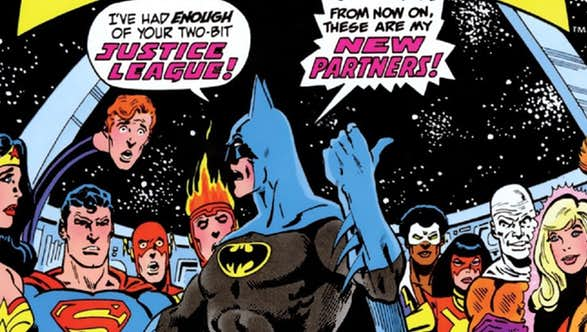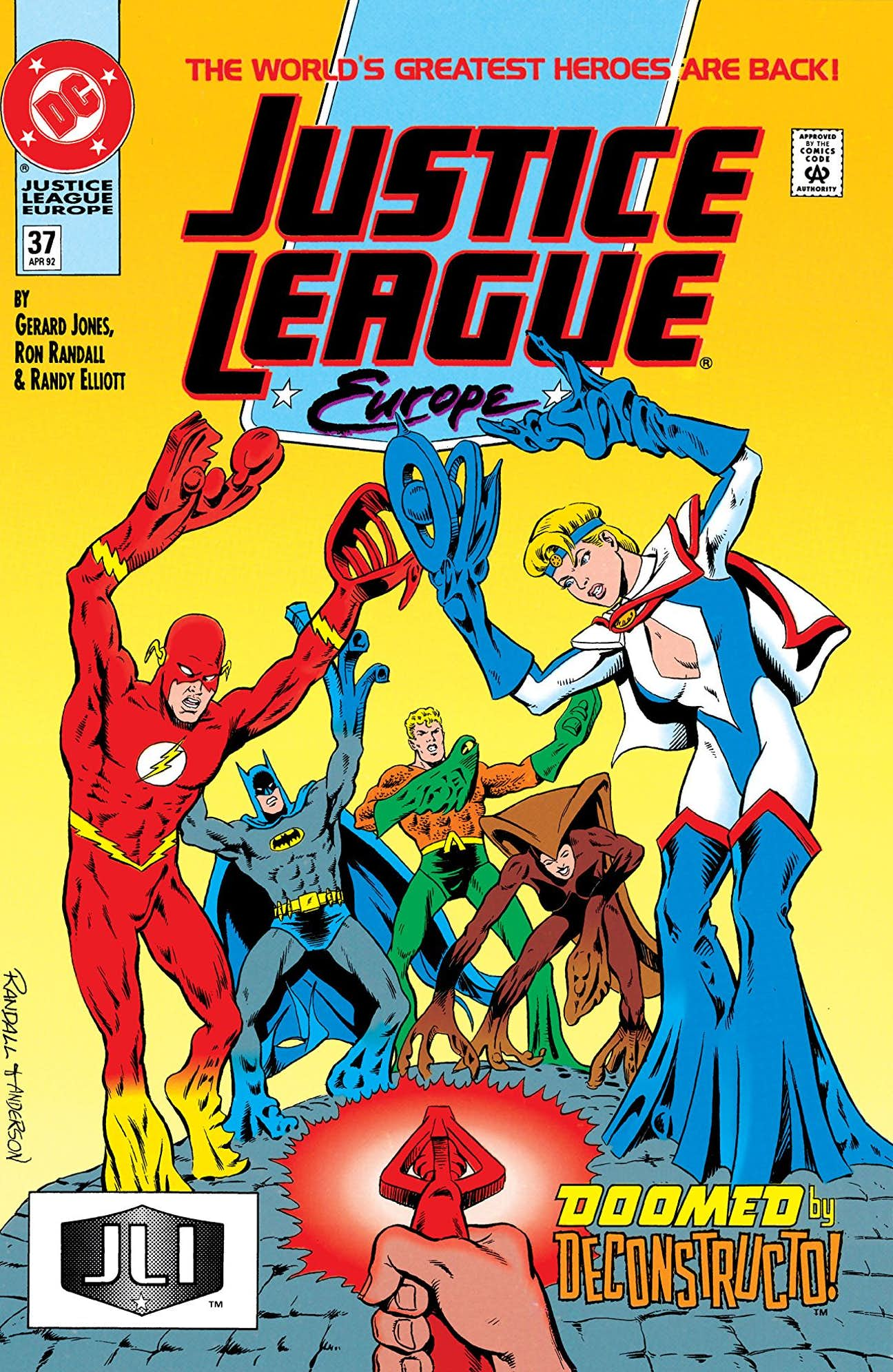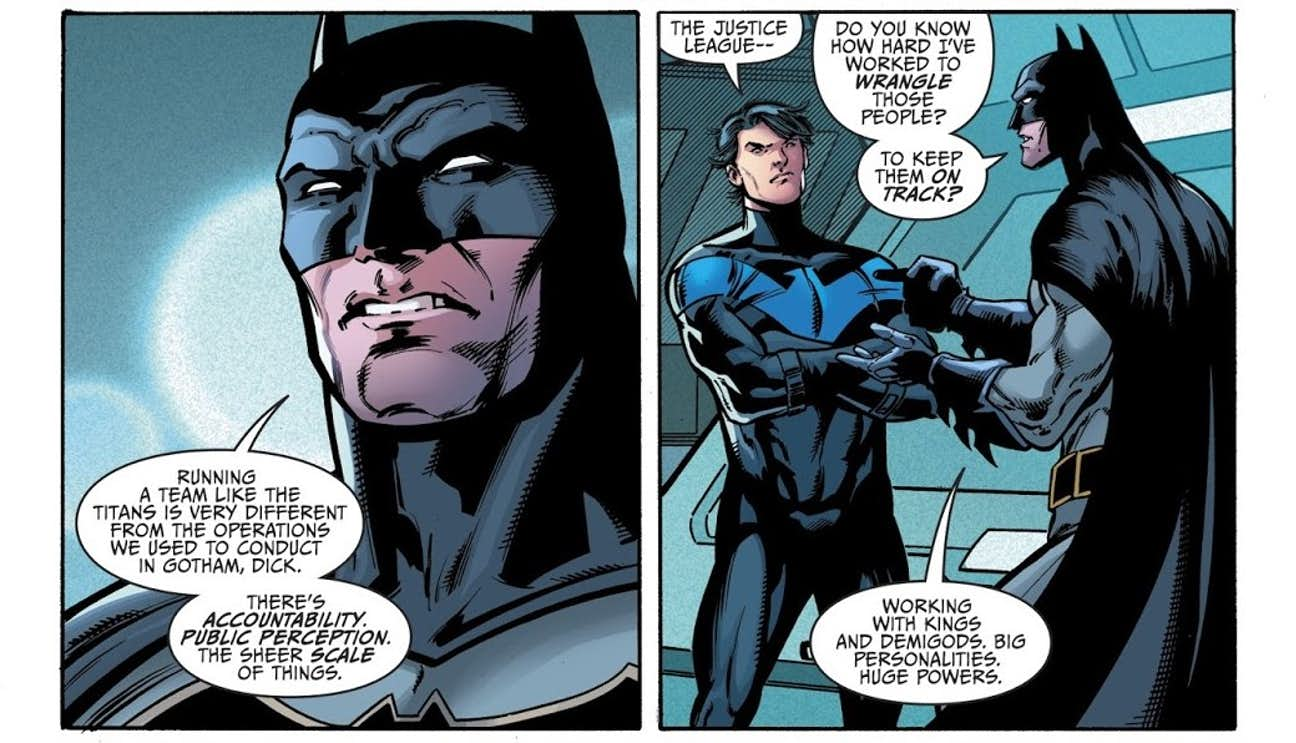
The Justice League’s unshakable spot atop DC’s super-team org chart made Batman’s 1983 departure all the more shocking (at least for 1983). Arguably he took a step down from that lofty berth to lead a group composed of new characters (Halo, Geo-Force, Katana) and a couple of characters who rejected League membership (Metamorpho and Black Lightning).
Reinforcing the League’s A-list status was its appearance of exclusivity. Over the course of 20 years and 175 issues (April-May 1961’s JLA issue #4 to June 1980’s issue #179), only nine additional members (ten if you count the Phantom Stranger) joined the seven founders prior to the Detroit era. Regardless of each new member’s merits, that’s not a rapid rate of roster change; and it made offers of League membership rare.
RELATED: DC’s Outsiders: Batman’s Black-Ops Team, Explained
Not only was the League fairly exclusive, but Silver and Bronze Age DC didn’t have that many all-star teams — that is, groups made of characters who appeared (or had appeared) in their own features. While there were plenty of super-teams, including the Doom Patrol, Metal Men and Challengers of the Unknown, they weren’t all-stars like the League or Teen Titans.

Paying tribute to the Silver Age’s JLA #9 on the cover of Justice League Europe #37
The sense of exclusivity also worked against the Detroit League, which — like the Outsiders and the megahit New Teen Titans — was built around a combination of familiar established characters and created-for-the-book newcomers. As a result, once the Detroit League folded, the Giffen/DeMatteis Justice League International reverted to the all-star formula. DC called this a “return to greatness,” although it used a number of newer, more malleable characters. Indeed, this pattern of all-star departures producing diminishing returns and leading to high-profile relaunches played out more than a few times: in 1992’s twin JLA and JLE relaunches, 1996’s “Morrison League,” 2009’s ill-fated Cry For Justice, and 2011’s New 52.
Starting with 1989’s Justice League Europe, the League expanded occasionally into multiple ongoing series. JLE ran for 68 issues (April 1989-September 1994) and was replaced on the schedule by Extreme Justice (19 issues, January 1995-July 1996). This period also included Justice League Task Force (38 issues, June 1993-August 1996), which started with a rotating-roster format and switched after about a year to a more traditional team of new and old characters. Once the Morrison League started and JLA was the League’s only title, this period of the early ’90s remained the only big expansion prior to the New 52. The main JLA series’ all-star format seemed to be enough for most readers.
Nevertheless, a handful of alternate Leagues popped up in miniseries. Writer Joe Kelly and penciller Doug Mahnke’s 2004-05 Justice League Elite was a 12-issue miniseries spun out of their JLA work. Similarly, Giffen and DeMatteis reunited with penciller Kevin Maguire for a couple of 6-issue Justice League International sequels, collected as Formerly Known As The Justice League (2004) and I Can’t Believe It’s Not The Justice League (2005). In 2009, incoming JLA writer James Robinson tried to launch a second ongoing series centered around Green Lantern and Green Arrow, but it morphed into the poorly-received Cry For Justice miniseries. Shortly thereafter, the 26-issue biweekly Justice League: Generation Lost miniseries (2010-11) promised a new Justice League International ongoing series, but those plans were scrapped in favor of the New 52 version.
RELATED: Kevin Maguire’s Justice League International Omnibus Cover is Epic
Speaking of which, the New 52’s Justice League International lasted 12 issues and an Annual (November 2011-October 2012). Six months after it ended, DC launched a new Justice League of America (14 issues, April 2013-October 2014); and then relaunched it as Justice League United (17 issues, June 2014-February 2016), turning it eventually into another rotating-roster quasi-anthology. Meanwhile, Justice League Dark (41 issues, November 2011-May 2015) became a New 52 mainstay, running from the relaunch’s beginnings until the “DC You” phase.
Needless to say, each of these spinoff teams had to justify its own existence. JL Europe gave the ostensibly-international group some Old World representation. JL Task Force went on unique or nontraditional missions. Extreme Justice and the Cry For Justice team were rooted in the hoary “proactive crimefighting” trope. The New 52’s JLI was only open to members without secret identities, and operated under United Nations scrutiny (unlike the less-regulated Justice League Prime). Similarly, the United States government created the New 52’s JLA specifically to oppose Justice League Prime; and when that JLA was officially disbanded, a handful of its members regrouped as JL United. Finally, JL Dark was mostly a Justice League in name only.
Now DC’s Rebirth initiative includes JL Prime (with a slightly-reworked lineup notable for its two Green Lanterns) and yet another Justice League of America. Both are all-star teams using pre-existing characters, with Batman forming the latest JLA as a response to Amanda Waller’s Suicide Squad. One imagines this sets up an inherent conflict between Batman’s responsibilities to the two teams.
Page 3: A Dark Knight In DemandComplicating matters is the fact that Batman is at the center of each team’s current storyline. In Christopher Priest and Pete Woods’ Justice League, he symbolizes everything people might think is wrong with superheroes (and has an evil doppelganger running around to boot); while in the Steve Orlando-written Justice League of America, the menace he assembled the team to fight has just reappeared on Earth.
RELATED: Bruce Wayne Finally Becomes a True Dark Knight in Batman #39
Furthermore, in March 2018’s Titans issue #19 Batman explains to Nightwing that he’s invested a lot of CEO-style management skills (to paraphrase) just to keep all those A-list egos and planet-leveling superpowers in check. (“Do you know how hard I’ve worked to wrangle those people?” he asks rhetorically.) Add to that his ongoing supervision of all the Gotham-based vigilantes, as seen in Detective Comics and the new Batman and the Signal miniseries, and the Darknight Detective looks to be stretched pretty thin.

Batman shares his management style with Nightwing in Titans #19
While this isn’t unusual, it can’t go on forever. Historically, Batman has tended to be on only one team at a time, with a couple of very brief exceptions. First, when Batman returned to the Outsiders in 2007, it lasted less than a year despite the book being called Batman and the Outsiders and running 14 issues. (Admittedly, that was part of Batman’s disappearance in Final Crisis.) A few years later, Batman’s time with the New 52’s Justice League International lasted just six issues.
To be clear, we’re assuming that Batman isn’t leaving the main Justice League. If he’s going to be on any team book, it’ll be that one. Besides, he’s clearly grooming Vixen (and/or Black Canary, speaking of someone who’s currently part of two teams) to take over for him. However, we see a way for DC to a) keep him as part of both books on an ongoing basis and b) broaden the scope of both titles.
Specifically, DC should find an in-universe way to bring both groups under the same umbrella, so that members of Justice League Prime can work with JLAers, and vice versa. This doesn’t have to happen all the time — writers Priest and Steve Orlando probably like the rosters they have — but on a certain level the Justice League is about organization. By putting members at the top of that org chart, the JL designation automatically confers a certain status on any team which bears it. That was part of the joke of “Justice League Antarctica” (these morons are officially Leaguers?) and probably why Justice League Dark wasn’t just another Shadowpact or Sentinels of Magic.
RELATED: Batman’s Failure Proves Fatal for [SPOILER] In Justice League
By the same token, though, any “secondary” League will be seen as lesser, because there’s only one main Justice League. In the JLA and JLE days of the late ’80s and early ’90s, the books got around that by making both teams part of the overall Justice League International. The JLA cast deserves to be under a similar umbrella, regardless of how often Batman appears. (Otherwise they’d just be called the Outsiders, and based on what we’ve seen in Dark Nights: Metal we think DC has plans for the Outsiders.) The members of the current JLA shouldn’t simply have “reserve” or “honorary-member” status. Many of them have been Leaguers previously (albeit in a different continuity), and they’ve all been picked by Batman. Therefore, as far as we’re concerned they’re Leaguers now; and they can stand alongside the members of JL Prime.
Besides, combining teams as in the JLI days would let Batman (and other Justice League Prime members) pop in and out as appropriate, even assuming Vixen or Black Canary has taken charge. It would also open the door to Justice League Prime having a Lobo, Atom or Killer Frost appearance every now and then. In fact, to paraphrase Batman’s Titans #19 diatribe, “[r]unning a team [involves] accountability[,] public perception [and] the sheer scale of things.” Folding the new Justice League of America into JL Prime would help keep Batman’s recruits (and by extension Batman himself) accountable to Superman, Wonder Woman and the rest.
Basically it would elevate the new JLA’s status while expanding JL Prime’s roster beyond the movie-ready elite. We think it’s a win-win for everyone. We just want to know where Green Arrow, Hawkman and Zatanna will end up….
Should Batman have to choose between two Justice Leagues? Let us know in the comments!

